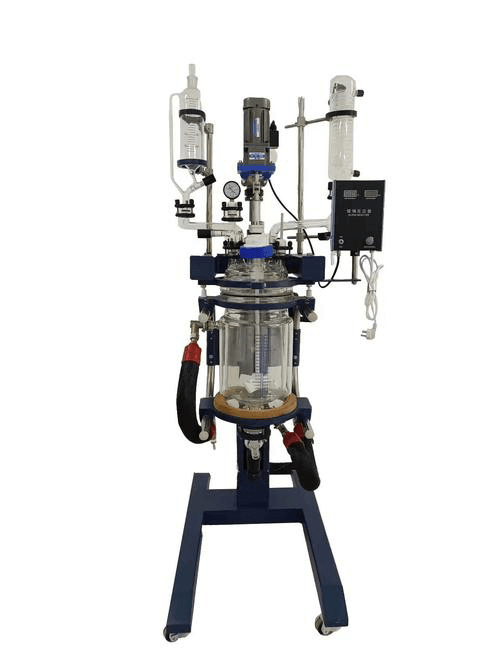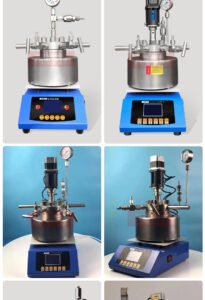Understanding the Benefits and Applications of the Manual Lift Glass Reactor
The manual lift glass reactor is a fundamental tool in modern laboratories, offering precise control over chemical reactions, distillation, and other experimental processes. Designed for efficiency and adaptability, this equipment plays a crucial role in various research and industrial applications. The EquilRxnLab AKSF-20L lifting and rotating double-layer glass reactor stands out due to its advanced features, durability, and ease of operation.

Key Features of the Manual Lift Glass Reactor
1. Large Capacity and Robust Material
The EquilRxnLab AKSF-20L manual lift glass reactor features a 20-liter volume, making it ideal for medium- to large-scale laboratory experiments. The jacket volume of 6 liters allows for efficient temperature regulation, ensuring optimal reaction conditions. Made from GG-17 borosilicate glass, this reactor provides excellent resistance to thermal shock and chemical corrosion, making it suitable for handling various aggressive substances.
2. Advanced Temperature Control for Precision Reactions
One of the most critical factors in laboratory experiments is precise temperature regulation. The manual lift glass reactor supports a temperature range from -80°C to 280°C, while its materials can withstand an even broader range from -120°C to 300°C. This wide range ensures that the reactor can accommodate both extremely low and high-temperature reactions, making it suitable for multiple applications, including crystallization, synthesis, and distillation.
3. Flexible and Ergonomic Design
The manual lifting mechanism provides researchers with greater flexibility in adjusting the reactor’s position, making it easier to handle, clean, and configure for various experimental setups. The 120° body angle enhances user convenience, allowing researchers to efficiently access the reactor’s contents.
4. Superior Vacuum Performance
Achieving a stable vacuum environment is crucial for many laboratory processes. The manual lift glass reactor operates at a vacuum level of 0.098 MPa, enabling precise pressure control for applications like solvent evaporation and vacuum distillation. This feature enhances efficiency and ensures high-purity results in chemical synthesis and purification procedures.
5. Efficient Stirring Mechanism with Digital Control
The manual lift glass reactor is equipped with a 90W stirring motor featuring digital frequency control, ensuring consistent and reliable performance. The stirring shaft is made of stainless steel coated with four fluorine materials, providing excellent chemical resistance and durability. With a speed range of 0-450 RPM, researchers can precisely control mixing intensity based on the requirements of their experiment.
6. Customizable Ports for Versatile Applications
The reactor is designed with six customizable ports, allowing researchers to integrate additional components such as condensers, dropping funnels, sensors, or gas inlets. This adaptability makes the manual lift glass reactor an ideal choice for laboratories conducting diverse experiments that require multiple inputs and outputs.
Benefits of Using the Manual Lift Glass Reactor
1. Enhanced Reaction Efficiency and Control
The combination of precise temperature control, vacuum regulation, and digital stirring ensures optimal conditions for chemical reactions, leading to higher yields and more reproducible results.
2. Greater Flexibility for Various Applications
From chemical synthesis and pharmaceutical development to material testing and biotechnology research, the manual lift glass reactor is an indispensable tool for laboratories requiring reliable and adaptable reaction vessels.
3. User-Friendly Operation and Maintenance
The manual lift mechanism simplifies cleaning and maintenance, reducing downtime between experiments. The ergonomic design ensures researchers can efficiently handle and adjust the reactor as needed.
4. Durable and Chemically Resistant Materials
Constructed from high-quality GG-17 borosilicate glass and fluorine-coated stainless steel, the manual lift glass reactor resists harsh chemicals, ensuring long-term durability and reliability.
Applications of the Manual Lift Glass Reactor
1. Chemical Synthesis and Catalysis
The reactor is widely used in organic and inorganic synthesis, providing controlled environments for developing new compounds and catalysts.
2. Pharmaceutical and Biotechnology Research
In the pharmaceutical industry, the manual lift glass reactor is essential for drug formulation and compound testing, ensuring precise control over reaction conditions.
3. Material Science and Nanotechnology
For researchers working with nanomaterials, polymers, or advanced coatings, the reactor’s ability to maintain stable reaction conditions is critical to achieving consistent material properties.
4. Distillation and Solvent Recovery
The reactor’s vacuum capabilities and temperature control make it ideal for distillation processes, solvent recycling, and purification applications.
Choosing the Right Manual Lift Glass Reactor
When selecting a manual lift glass reactor, it’s essential to consider factors such as reactor volume, temperature range, stirring capacity, and port configurations. The EquilRxnLab AKSF-20L reactor offers an excellent balance of precision, efficiency, and durability, making it a top choice for laboratories seeking a high-performance solution.
For more details on the AKSF-20L manual lift glass reactor, visit EquilRxnLab: AKSF-20L Lifting and Rotating Double-Layer Glass Reactor.
Additional Resources
To stay updated with the latest developments in EquilRxnLab products, explore the following links:



